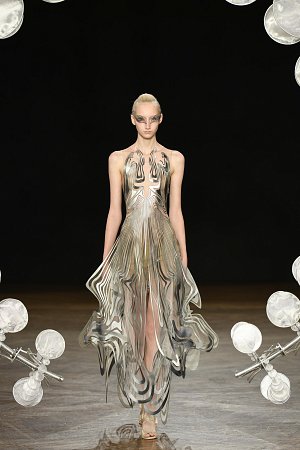
Iris van Herpen, Suminagashi dress, “Hypnosis” collection, 2019
Polyurethane, mylar, tulle. Iris van Herpen
Collection
© Dominique Maitre
Sensory sea life
Under the surface of the oceans, there
is a world invisible to the naked eye,
nonetheless fundamental to life on Earth.
Iris van Herpen’s 2020 collection,
“Sensory Seas”, draws inspiration from
this ecosystem and its planktonic bestiary,
and on a broader scale, from sea animals,
that shape the designs and textures
of her dresses. Single-cell organisms
and the hydrozoa family like jellyfish,
are the designer’s most constant form
of inspiration. They are her fundamental
reference point as she seeks to put
them into light in her works. Just as 19th
century master glassmakers Leopold and
Rudolf Blaschka revealed this elusive
world with their astonishing pedagogical
models, Iris van Herpen takes up the same
subjects and transposes them, between
craftsmanship and new technologies,
into the field of Haute Couture.
Water and dreams
Liquid, frozen, or as gas, water is regularly
present in Iris van Herpen’s work, even
becoming the principal focus of her
2010 “Crystallization” collection. Major
component of the human body, water
splashes out of her dresses to transcend
the invisible flux that constitutes our very
essence. On every level–from drop of rain
to tsunami, as a poetical allegory or gate
to the shadow world, representing both
harmony and chaos, in the form of foam,
crystallized liquid or waves, water inspires
the designer’s fertile creativity. Bubbles
suspended in space, transparent fields
of mist, turquoise or deep blue waves, Iris
van Herpen’s aquatic pieces reveal the
mystery and metaphorical power of water,
manifested across a multitude of fabrics,
materials, and techniques from blown
glass to thermoformed Plexiglas, from
laser cutting to Suminagashi, a Japanese
technique of marbled ink drawings.
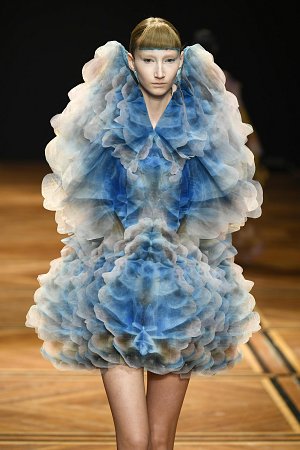
Iris van Herpen, in collaboration with Kim Keever, Cosmica minidress, “Shift Souls” collection, 2019
Silk organza, cotton. Iris van Herpen Collection
© Dominique Maitre
Forces behind the forms
Iris van Herpen’s fascination for shapes
found in nature has led her to reflect
on morphogenesis and the creative forces
at the origin of life. The microscopically
small has asserted itself as revelatory
of the beauty of invisible bestiaries and
pointed her towards a new aesthetic
grammar and materials that transcend the
field of fashion. In that perspective, she
manifests a particular interest in biologist
Ernst Haeckel, whose illustrated plates
shed light on microscopic beings, in the
19th century. Mixing art and science, the
designer explores terrestrial and marine
worlds to unearth new structures and
textures. Her preoccupation with the
preservation of the environment has led
her to re-examine how we see the world,
notably in her “Earthrise” collection,
created with artist Rogan Brown, in which
she chooses to magnify recycled plastic.
Skeletal embodiment
Cabinets of curiosities and anatomical
museums are fertile ground for Iris
van Herpen. Like Michelangelo and
Jean‑Antoine Houdon, who also studied
anatomical representations of the
human being, the designer analyses
the skeleton, muscles, fascias, and the
systems of the body to create figures that
wear like a second skin. Her dresses are
hybrid structures, becoming a projection
of our intrinsic constitution, creating
the fiction of a new body. Exploring the
frontier between living and inert, Iris van
Herpen gives new life to the silhouette.
Her clothing, like a mutation of complex
anatomical forms, is an extension of the
body. She brings light and perspective
to that which is barely perceptible
through the skin’s transparency, only
able to be revealed through technology.
Her designs are an artistic MRI, a creative
x-ray of the structure of living things.

Janaina Mello Landini, Ciclotrama 310 (from the Superstrato series), 2023
Various threads (sisal, cotton) on linen canvas
© Les Arts Décoratifs / Christophe Dellière
Growth systems
Thanks to her holistic approach, Iris van
Herpen is interested in the existence of all
structures, whether natural or artificial,
organic or architectural. The human
body is both unique and part of a whole,
connected to, and by, its physicality, but
also its spirit, soul, memory, and roots.
From the singularities of the living world,
Iris van Herpen extracts ecosystems,
processes of growth, interconnections.
Mushrooms, one of the reigning species
of our planet, are part of the underworld,
weaving connections with filaments
of mycelium that seduce the designer
both with their beauty and the intelligence
of their generative system. An ode
to nature, the “Roots of Rebirth” collection
is an homage to this infinitesimally thin
underground organic web. A celebration
of flamboyant Gothic, her Cathedral Dress
reinvents the codes of fashion.
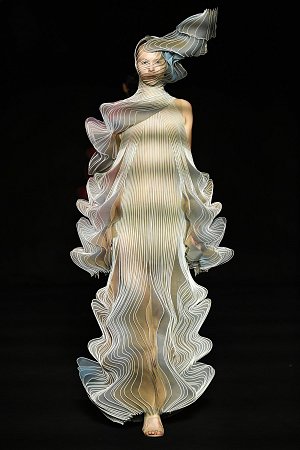
Iris van Herpen, Frozen Falls dress and headdress, “Syntopia” collection, 2018
Komon Kobo, organza,
mylar, tulle.
Iris van Herpen collection
© Dominique Maitre
Synaesthesia
The body’s materiality, anatomy, and
sensory systems clearly resonate
throughout Iris van Herpen’s creations,
but other dimensions of the human
experience also fascinate and inspire
her. The interest she takes in the brain,
and more particularly in synesthesia
and complex phenomena of modified
states of consciousness, such as lucid
dreaming and hypnosis, permit her
to stretch the boundaries of fashion
to something more than just a visual
or tangible experience of a piece of
clothing. Fascinated by neurological
research, she seeks to trouble perception,
to magnify the senses, to sculpt them
along with the materials she chooses.
How to dilute the frontiers of perception?
How to stimulate the brain with all five
senses working together to provoke
a new emotional experience?
Alchemic atelier
The Achemic Atelier pays tribute
to Iris van Herpen’s career with
a presentation of hundreds of spectacular
samples, created in collaboration
with numerous artists, architects,
designers and scientists. Revealing
the multiple processes that she
used, these pieces result from
a combination of new technologies
and traditional craftsmanship.
Cabinet of curiosities
Organized like a 21st Century cabinet
of curiosities, this space reflects Iris van
Herpen’s multiple sources of inspiration.
This eclectic selection reveals her love
of discovery, her interest in disciplines
both adjacent to and distant from fashion,
and her fascination with our world’s
richness and diversity. An encyclopaedic
representation of Iris van Herpen’s career,
this cabinet is a synthesis of her endless
creativity, her holistic approach and
her talent for generating connections
between worlds.
The mythology of fear
Iris van Herpen was born in the village
of Wamel, near Den Bosch, town
of Flemish painter Hieronymus Bosch.
She grew up examining with intensity the
artist’s fantastical figures that mix alchemy,
mysticism, and allegory. From her study
of Bosch, she retains a certain taste for
hybridization, an incessant questioning
of human and animal nature, and
an interest in fusing both into chimerical
beings. In parallel, she explores the
emotion of fear inside these imaginary
worlds, through her discoveries made
in the collections of the Embassy of the
Free Mind, in Amsterdam, and in cabinets
of curiosities encountered in her studies
of Art History. Symbolist and Surrealist
literature, have also led her to venture
metaphor as a prism for expression,
elevating her work above conventional
dressing classifications. From Ovid’s
Metamorphoses to Japanese mythology,
she loves reinterpreting the mutations
of our world.
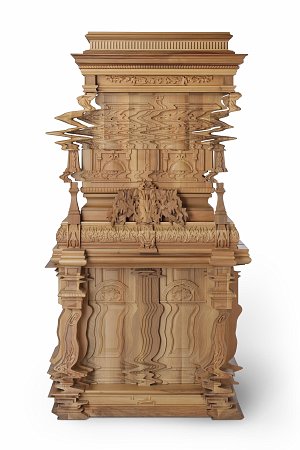
Ferruccio Laviani, Good Vibrations Cabinet, 2013
Designed for Fratelli Boffi
Solid walnut, oak finish,
carved, chiselled and
digitally engraved
© Les Arts Décoratifs / Christophe Dellière
New nature
In many of her collections, Iris van
Herpen’s life-line silhouettes celebrate
a new and futuristic concept of nature.
In her perception of an imaginary
future, she is above all interested in the
distinction between nature and artifice
in a society caught up in its fascination
with the growing presence of virtual
reality. By questioning the presence
of the body in a post-human world,
the designer invites us to contemplate
a society that is increasingly living “insideout.”
In her “Syntopia,” “Escapism,” and
“Voltage” collections, she interrogates
the link between technology and science.
Fascinated by the world of tomorrow,
Iris van Herpen melds disciplines, weaving
them together, giving birth to a new
definition of fashion in which the garment
creates a metamorphosis, transforming
the body into a hybrid creature – the
incarnation of a futuristic world view.
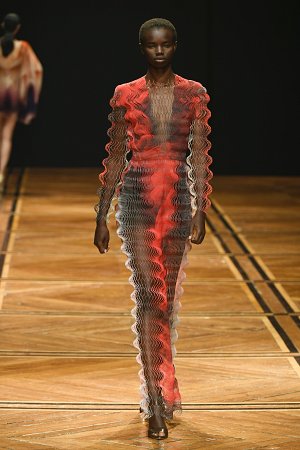
Iris van Herpen, in collaboration with Philip Beesley Galactic, Glitch dress, “Shift Souls” collection, 2019
Komon Kobo, mylar.
Iris van Herpen
Collection
© Dominique Maitre
Cosmic bloom
In her exploration of the cosmos, Iris van
Herpen shows her talent for synthesis,
combining the latest scientific discoveries
with the history of art and science,
blending the ancient maps of Andreas
Cellarius with images from the James
Webb telescope. The cosmos and its
mysteries pique her imagination and
her creativity. Like a metaphor of her
holistic approach, the cosmos incarnates
a space in which one can deploy oneself
without limit, a symbol of absolute liberty.
Colours float and come alive, offering new
horizons for a body in levitation. For the
designer, to understand the cosmos
is to overturn the order of time and space
and achieve elevation. The world becomes
an all-encompassing entity, greater than
the confines of planet Earth. It no longer
develops from bottom up or top down,
but in all of its dimensions simultaneously,
as a multiverse, with no borders except
those of the mind and the imagination,
the soul and its cosmic journey.